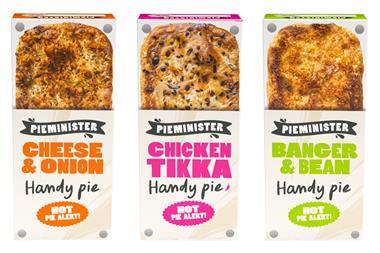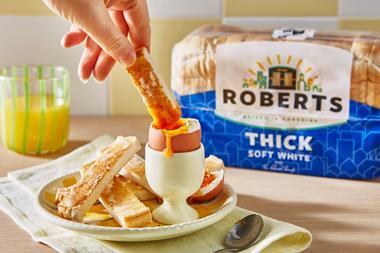Week six of The Great British Bake Off, and our two professional bakers, Gerhard Jenne and Charlotte Green, take a look at the remaining bakers’ buns.
Gerhard Jenne
"Ruby is in with a chance. I can see her as the pin-up for a whole new generation of bakers."
I was looking forward to the dough challenge. As a trained baker as well as a pastry chef, I’ve always had a fondness for yeast baking. Sadly it seems to get drowned out by self-raising cupcakes and other time-saving recipes.
Ruby got it right when she said she normally bakes with yeast while chilling out at home – it’s one that takes time. She did very well with all three challenges, even winning the star baker accolade. I have it on authority that the BBC is already working on the book by the winner. Last night I thought Ruby was in with a chance. I can see her as the pin-up for a whole new generation of bakers.
As I’m originally from Germany I know about the powers of a good bun. While at school I used to excuse myself five minutes before the morning break just so I could get my hands on a “Mohnschnecke” a poppyseed filled schnecken bun, fresh from the baker’s stall. No one attempted those in the GBBO, but there were loads of other Continental-inspired twisted and stuffed ones. And I strongly disagreed with Paul and Mary who said prunes don’t work in buns; semi-dried prunes are often found in an Austrian bun called Buchteln and no German cake shop gets by without offering Zwetschgenkuchen, a bun dough base topped with fresh plums, even sharp ones, as long as they are sprinkled with cinnamon sugar and preferably served with whipped cream – excited wasps all over Germany will agree too.
The only ones with a sting in their tale on GBBO, though, were Paul and Mary, I thought it was interesting that no one made a starter for their enriched doughs and neither of them mentioned that in their deliberations. Maybe I missed something, but I always thought it is best to give the yeast the chance to develop first, before putting it to work with all that lifting of fats and fruit.
There were some visual stunners: Kimberley’s twisted French plait, Christine’s raspberry custard buns, the ‘noughts’ of Frances’ bake, based on a Czech bun, Ruby’s chocolate twists – and they all delivered on taste. Paul Hollywood was excited, so much so, his salt and pepper hair had so much gel in it, it looked like a streaky iced bun itself.
Howard’s peach buns were an amazing accomplishment. So much love had gone into them, weighing the buns down with a spoon to give them that dimple, giving them a bit of blushing cheek with rouge after the bake. I thought he was going to walk away a winner, but sadly all the presentation and beautiful execution didn’t hide the fact that they didn’t deliver on taste, the all-important major factor.
Charlotte Green
"There was really nothing in it between Howard and Glenn for last place."
The traditional tea loaf can be whipped up in next to no time at home, by forgoing the true method of adding yeast and proving, and using self-raising flour instead. But this was not an option for the seven remaining bakers, who were naturally required to do things properly. This, of course, led to difficulties, because sugar, used to enrich the sweet dough, retards yeast, and adding fruits (which are bursting with yet more natural sugars) can compound this problem even further.
Some nice tea flavours were being used to soak the fruits, including Chai and Assam. I like to use Earl Grey, which imparts its delicious bergamot orange flavour and is more readily found in the average kitchen cupboard.
Some of the bakers added their tea-soaked fruits before the first proofing, and were disappointed with the results, as the extra sugars impaired the yeast badly. This underproofing had a knock-on effect at the baking stage, and only Frances managed a tea loaf that was fully cooked. Howard’s ‘healthy looking’ offering had spread for lack of a loaf tin, and his hemp flavour – which had earlier mystified an innocent Mary – didn’t really work. Christine probably fared worst, with Paul declaring, “I can’t eat this” as he cut into raw dough.
This week’s Technical Challenge featured Paul’s choice of Apricot Couronne, and Mary was clearly delighted as she commented “You’re very cruel!” Actually though, the bakers did rather well on the whole. This light dough, which uses full fat milk to soften the gluten structure and retain moisture, must be kneaded well to avoid spreading, and I think the contestants have developed their kneading skills sufficiently. Judging when a dough is properly proofed still presents a problem, though, and Howard removed his too early. I don’t see many of the bakers testing their dough for spring-back, which may be the mistake.
Rolling and shaping the couronnes was also problematic for some, with those bakers who (somewhat understandably) twisted their dough with the filling on the inside, finding that the sugars inhibited the second proving. This led Howard and Glenn’s bakes to turn out thin, whilst Christine’s was uneven.
The final challenge was to create two varieties of European sweet buns, and extra time was given to allow for the 12-hour refrigerated resting time needed for the batter-like dough to firm up enough for shaping.
Whilst many contestants opted for a variation on brioche, Christine went for German Schnecken buns and some impressive Norwegian Vanilla Custard Skolebrød, and made both varieties look effortless. Glenn inexplicably filled the cups of his tray with caramel, which later meant his baked dough was stuck fast. Ruby’s sweet buns came out of the oven very dark and she looked mournful, but the judges called them “delicious”, and after a good all-round effort, she reclaimed the star baker title.
There was really nothing in it between Howard and Glenn for last place, but Howard was chosen for elimination, which is a shame because his personality and interesting recipe experiments really added something to the show. Ruby, Christine and Kim are all looking strong as we move on to pastry next week.
You can read Gerhard’s blog here.
Follow Konditor & Cook on Twitter: @konditorandcook
- See more at: http://www.bakeryinfo.co.uk/news/fullstory.php/aid/11868/The_Great_British_Blog_Off:_Week_5.html#sthash.bWlchncV.dpufYou can read Gerhard’s blog here.
Follow Konditor & Cook on Twitter: @konditorandcook
Charlotte’s personal blog can be found here.
Follow Langs of London on Twitter: @LangsofLondon
- See more at: http://www.bakeryinfo.co.uk/news/fullstory.php/aid/11868/The_Great_British_Blog_Off:_Week_5.html#sthash.bWlchncV.dpufYou can read Gerhard’s blog here.
Follow Konditor & Cook on Twitter: @konditorandcook
Charlotte’s personal blog can be found here.
Follow Langs of London on Twitter: @LangsofLondon
- See more at: http://www.bakeryinfo.co.uk/news/fullstory.php/aid/11868/The_Great_British_Blog_Off:_Week_5.html#sthash.bWlchncV.dpufYou can read Gerhard’s blog here.
Follow Konditor & Cook on Twitter: @konditorandcook
Charlotte’s personal blog can be found here.
Follow Langs of London on Twitter: @LangsofLondon
































No comments yet